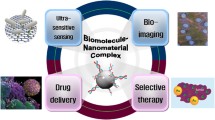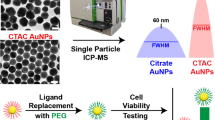Abstract
Aptamer guided nanomedicine shows great promise in targeted cancer therapies. However the loss of targeting capacity during in vivo or clinical trials has largely hindered its popularity and there are no systematic studies to elucidate the causes. Herein, we investigated such loss of targeting capacity by examining how the physiological milieu affected targeting effect. Aptamer functionalized gold nanoparticle (AuNP) was chosen as the model and exposed to human blood serum that is used to mimic physiological milieu. Dynamic light scattering (DLS), flow cytometry and label-free liquid chromatography tandem mass spectrometry (LC-MS/MS) were employed to determine variations of NPs’ surface chemistry and biological identities changes after serum exposure. Results showed that the targeting ability loss was caused by protein corona blocking, replacement and enzymatic cleavage of surface aptamer targeting ligands. Noteworthy, the aggregation issue is critical for the smaller NPs. Analysis of the protein corona profile indicated the accumulation of immune-related proteins on the surface of aptamer-conjugated NPs, which could induce immune response, resulting in rapid clearance of NPs.

Similar content being viewed by others
References
Pelaz, B.; Alexiou, C.; Alvarez-Puebla, R. A.; Alves, F.; Andrews, A. M.; Ashraf, S.; Balogh, L. P.; Ballerini, L.; Bestetti, A.; Brendel, C. et al. Diverse applications of nanomedicine. ACS Nano 2017, 11, 2313–2381.
Chow, E. K. H.; Ho, D. Cancer nanomedicine: From drug delivery to imaging. Sci. Transl. Med. 2013, 5, 216rv4.
Shi, J. J.; Kantoff, P. W.; Wooster, R.; Farokhzad, O. C. Cancer nanomedicine: Progress, challenges and opportunities. Nat. Rev. Cancer 2017, 17, 20–37.
Wilhelm, S.; Tavares, A. J.; Dai, Q.; Ohta, S.; Audet, J.; Dvorak, H. F.; Chan, W. C. W. Analysis of nanoparticle delivery to tumours. Nat. Rev. Mater. 2016, 1, 16014.
Sykes, E. A.; Chen, J.; Zheng, G.; Chan, W. C. W. Investigating the impact of nanoparticle size on active and passive tumor targeting efficiency. ACS Nano 2014, 8, 5696–5706.
Hong, H.; Yang, K.; Zhang, Y.; Engle, J. W.; Feng, L. Z.; Yang, Y.; Nayak, T. R.; Goel, S.; Bean, J.; Theuer, C. P. et al. In vivo targeting and imaging of tumor vasculature with radiolabeled, antibody-conjugated nanographene. ACS Nano 2012, 6, 2361–2370.
Wang, X. W.; Gao, W.; Fan, H. H.; Ding, D.; Lai, X. F.; Zou, Y. X.; Chen, L.; Chen, Z.; Tan, W. H. Simultaneous tracking of drug molecules and carriers using aptamer-functionalized fluorescent superstable gold nanorodcarbon nanocapsules during thermo-chemotherapy. Nanoscale 2016, 8, 7942–7948.
Huang, L.; Li, Z. J.; Zhao, Y.; Zhang, Y. W.; Wu, S.; Zhao, J. Z.; Han, G. Ultralow-power near infrared lamp light operable targeted organic nanoparticle photodynamic therapy. J. Am. Chem. Soc. 2016, 138, 14586–14591.
Shangguan, D.; Bing, T.; Zhang, N. Cell-SELEX: Aptamer selection against whole cells. In Aptamers Selected by Cell-SELEX for Theranostics. Tan, W.; Fang, X., Eds.; Springer: Berlin, Heidelberg, 2015; pp 13–33.
Kuai, H. L.; Zhao, Z. L.; Mo, L. T.; Liu, H.; Hu, X. X.; Fu, T.; Zhang, X. B.; Tan, W. H. Circular bivalent aptamers enable in vivo stability and recognition. J. Am. Chem. Soc. 2017, 139, 9128–9131.
Zhao, Z. L.; Fan, H. H.; Zhou, G. F.; Bai, H. R.; Liang, H.; Wang, R. W.; Zhang, X. B.; Tan, W. H. Activatable fluorescence/MRI bimodal platform for tumor cell imaging via MnO2 nanosheet–aptamer nanoprobe. J. Am. Chem. Soc. 2014, 136, 11220–11223.
Liu, Q. L.; Jin, C.; Wang, Y. Y.; Fang, X. H.; Zhang, X. B.; Chen, Z.; Tan, W. H. Aptamer-conjugated nanomaterials for specific cancer cell recognition and targeted cancer therapy. NPG Asia Mater. 2014, 6, e95.
Wang, Y.; Li, Z. H.; Weber, T. J.; Hu, D. H.; Lin, C. T.; Li, J. H.; Lin, Y. H. In situ live cell sensing of multiple nucleotides exploiting DNA/RNA aptamers and graphene oxide nanosheets. Anal. Chem. 2013, 85, 6775–6782.
Wang, S. S.; Liu, Z. K.; Zou, Y. X.; Lai, X. F.; Ding, D.; Chen, L.; Zhang, L. Q.; Wu, Y.; Chen, Z.; Tan, W. H. Elucidating the cellular uptake mechanism of aptamer-functionalized graphene-isolated-Au-nanocrystals with dual-modal imaging. Analyst 2016, 141, 3337–3342.
Perrault, S. D.; Walkey, C.; Jennings, T.; Fischer, H. C.; Chan, W. C. W. Mediating tumor targeting efficiency of nanoparticles through design. Nano Lett. 2009, 9, 1909–1915.
Tan, W. H.; Donovan, M. J.; Jiang, J. H. Aptamers from cell-based selection for bioanalytical applications. Chem. Rev. 2013, 113, 2842–2862.
Nel, A. E.; Mädler, L.; Velegol, D.; Xia, T.; Hoek, E. M. V.; Somasundaran, P.; Klaessig, F.; Castranova, V.; Thompson, M. Understanding biophysicochemical interactions at the nano-bio interface. Nat. Mater. 2009, 8, 543–557.
Tenzer, S.; Docter, D.; Kuharev, J.; Musyanovych, A.; Fetz, V.; Hecht, R.; Schlenk, F.; Fischer, D.; Kiouptsi, K.; Reinhardt, C. et al. Rapid formation of plasma protein corona critically affects nanoparticle pathophysiology. Nat. Nanotechnol. 2013, 8, 772–781.
Cedervall, T.; Lynch, I.; Lindman, S.; Berggard, T.; Thulin, E.; Nilsson, H.; Dawson, K. A.; Linse, S. Understanding the nanoparticle–protein corona using methods to quantify exchange rates and affinities of proteins for nanoparticles. Proc. Natl Acad. Sci. USA 2007, 104, 2050–2055.
Walkey, C. D.; Olsen, J. B.; Guo, H. B.; Emili, A.; Chan, W. C. Nanoparticle size and surface chemistry determine serum protein adsorption and macrophage uptake. J. Am. Chem. Soc. 2012, 134, 2139–2147.
Salvati, A.; Pitek, A. S.; Monopoli, M. P.; Prapainop, K.; Bombelli, F. B.; Hristov, D. R.; Kelly, P. M.; Åberg, C.; Mahon, E.; Dawson, K. A. Transferrin-functionalized nanoparticles lose their targeting capabilities when a biomolecule corona adsorbs on the surface. Nat. Nanotechnol. 2013, 8, 137–143.
Dai, Q.; Walkey, C.; Chan, W. C. W. Polyethylene glycol backfilling mitigates the negative impact of the protein corona on nanoparticle cell targeting. Angew. Chem., Int. Ed. 2014, 53, 5093–5096.
Walkey, C. D.; Chan, W. C. W. Understanding and controlling the interaction of nanomaterials with proteins in a physiological environment. Chem. Soc. Rev. 2012, 41, 2780–2799.
Perrault, S. D.; Chan, W. C. W. Synthesis and surface modification of highly monodispersed, spherical gold nanoparticles of 50−200 nm. J. Am. Chem. Soc. 2009, 131, 17042–17043.
Chou, L. Y. T.; Chan, W. C. W. Fluorescence-tagged gold nanoparticles for rapidly characterizing the size-dependent biodistribution in tumor models. Adv. Healthc. Mater. 2012, 1, 714–721.
Shangguan, D. H.; Li, Y.; Tang, Z. W.; Cao, Z. C.; Chen, H. W.; Mallikaratchy, P.; Sefah, K.; Yang, C. J.; Tan, W. H. Aptamers evolved from live cells as effective molecular probes for cancer study. Proc. Natl Acad. Sci. USA 2006, 103, 11838–11843.
Chinen, A. B.; Guan, C. M.; Mirkin, C. A. Spherical nucleic acid nanoparticle conjugates enhance G-quadruplex formation and increase serum protein interactions. Angew. Chem. 2015, 127, 537–541.
Hallick, R. B.; Chelm, B. K.; Gray, P. W.; Orozco, E. M. Use of aurintricarboxylic acid as an inhibitor of nucleases during nucleic acid isolation. Nucleic Acids Res. 1977, 4, 3055–3064.
Wang, H.; Yang, R. H.; Yang, L.; Tan, W. H. Nucleic acid conjugated nanomaterials for enhanced molecular recognition. ACS Nano 2009, 3, 2451–2460.
Liang, H.; Zhang, X.-B.; Lv, Y. F.; Gong, L.; Wang, R. W.; Zhu, X. Y.; Yang, R. H.; Tan, W. H. Functional DNA-containing nanomaterials: Cellular applications in biosensing, imaging, and targeted therapy. Acc. Chem. Res. 2014, 47, 1891–1901.
Cedervall, T.; Lynch, I.; Foy, M.; Berggård, T.; Donnelly, S. C.; Cagney, G.; Linse, S.; Dawson, K. A. Detailed identification of plasma proteins adsorbed on copolymer nanoparticles. Angew. Chem., Int. Ed. 2007, 46, 5754–5756.
Lazarovits, J.; Chen, Y. Y.; Sykes, E. A.; Chan, W. C. W. Nanoparticleblood interactions: The implications on solid tumour targeting. Chem. Commun. 2015, 51, 2756–2767.
Walkey, C. D.; Olsen, J. B.; Song, F. Y.; Liu, R.; Guo, H. B.; Olsen, D. W. H.; Cohen, Y.; Emili, A.; Chan, W. C. W. Protein corona fingerprinting predicts the cellular interaction of gold and silver nanoparticles. ACS Nano 2014, 8, 2439–2455.
Acknowledgements
We would like to acknowledge Dr. Yanyan Lin at The First Hospital of Lanzhou University for donation of blood samples. We would also like to thank Dr. Jianglin Li for performing LC-MS/MS. This work was financially supported by the National Natural Science Foundation of China (Nos. 21522501, 21521063 and 61673405), Hunan Provincial Natural Science Foundation of China (No. 2018JJ1007), and the Science and Technology Development Fund of Macao S.A.R (FDCT, 097/2015/A3).
Author information
Authors and Affiliations
Corresponding authors
Electronic supplementary material
Rights and permissions
About this article
Cite this article
Ding, D., Zhang, Y., Sykes, E.A. et al. The influence of physiological environment on the targeting effect of aptamer-guided gold nanoparticles. Nano Res. 12, 129–135 (2019). https://doi.org/10.1007/s12274-018-2191-9
Received:
Revised:
Accepted:
Published:
Issue Date:
DOI: https://doi.org/10.1007/s12274-018-2191-9




